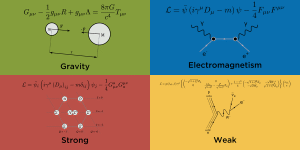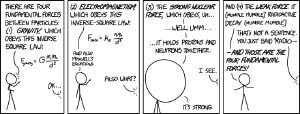Blog
The Four Horsemen
25 February 2015
 Brian Koberlein
Brian KoberleinIn physics it’s often said that there are four fundamental forces: gravity, electromagnetism, strong, and weak. The reason we list them as four forces has a bit to do with the history of our understanding of them. In the 1700s, the forces of electricity and magnetism were considered to be separate, but by the mid 1800s James Clerk Maxwell unified them into a general theory of electromagnetism. Soon general relativity was first validated, a unified theory of electromagnetism and gravity known as the Kaluza-Klein model was developed. This classical model ran into difficulties integrating with quantum theory, so the model fell out of favor. Later, electromagnetism was unified with the weak to form the electroweak model, but since their unified behavior only appears at high energies we continue to treat them as distinct forces.
 Randall Munroe
Randall MunroeMost people are familiar with gravity and electromagnetism in their daily lives, while the strong force holds atomic nuclei together, and the weak … something something … radioactivity. Even many physics majors aren’t given more than a cursory overview of the strong and weak forces, so while we all know the list, we’re less clear in describing them. While some fields of study can get away with focusing on one or two of these forces, all four of them are central to astrophysics.
So this week I’ll look at these four forces, specifically within the context of astrophysics:
Gravity: forge of the universe
Electromagnetism: forge of planets and stars
Strong: forge of atoms
Weak: forge of life
We’ll start with gravity first. It’s the force everyone knows, but no one fully understands. It all starts tomorrow.